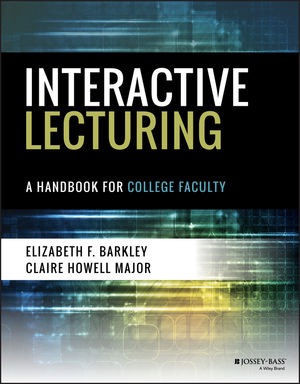presentations
Select an item by clicking its checkbox
I’ve been reviewing instructional video presentations for a project. Primarily I screen them to review how effective the presenter is in applying sound pedagogy. It’s amazing how many basic rules of good communication presenters break—consistently—-even professional speakers and celebrated “master teachers.” The other side of the ...

Interactive Lecturing: A Handbook for College Faculty
Date Reviewed: March 8, 2019
Barkley and Major have compiled an invaluable compendium of information about improving on traditional class lectures by including interactive elements. Like McKeachie’s Teaching Tips or Davis’ Tools for Teaching, this book can be read cover to cover or approached as a resource to consult when needed, as just about every page includes some practical suggestions for improving teaching and student engagement. The book opens with a two-chapter consideration of what the authors call a “Conceptual Framework for Interactive Learning.” These chapters examine the benefits and drawbacks of lectures and active learning strategies as well as the wide variety of each, arguing ultimately for an integrative model that takes advantage of the best of both approaches. The suggestions in these chapters and throughout the book are based on recent research rather than recourse to traditional arguments about the superiority of one modality over another. The ultimate strengths of this book, beyond the sheer volume of useful information, are its thoughtful mix of approaches and avoidance of a one-size-fits-all approach, all presented in concrete, actionable terms.
This handbook is divided into three parts: the conceptual opening, twelve chapters on Engaging Presentation Tips, and eight chapters on Active Learning Techniques. The second two parts include 53 tips for creating engaging presentations and 32 suggestions for active learning techniques, most illustrated through specific examples. These are previewed at the beginning of each relevant chapter in a simple chart that directs reader attention to what each tip aims to improve and directions for implementing changes. Although it is impossible to itemize those tips here, it is indicative of the scope of the handbook’s broad coverage that the index includes subjects as diverse as voice modulation, metacognitive reflection, “dead wood words,” and background color of slides. Overall, Barkley and Major suggest many simple changes to the typical lecture that can result in more student engagement, such as how to devise a “power close” to any lecture; how to structure and practice presentations with, for instance, a “weatherperson” approach; and how to guide students in taking “sketch notes” during lectures. From “Guess and Confirm” to “Translate That!” to sticky note diagrams, these authors provide a wealth of possibilities to teachers and their students for making lectures interactive and engaging.
The approaches in this book are meant to work across disciplines and teaching platforms, including online and hybrid modalities. It is not geared to beginning or veteran teachers but rather to any teacher who wants to improve the classroom experience for students and for themselves. The advice here is rich, practical, and based on research, experience, and common sense. This book seems ideal for individual use but also for any departmental faculty resource collection.
